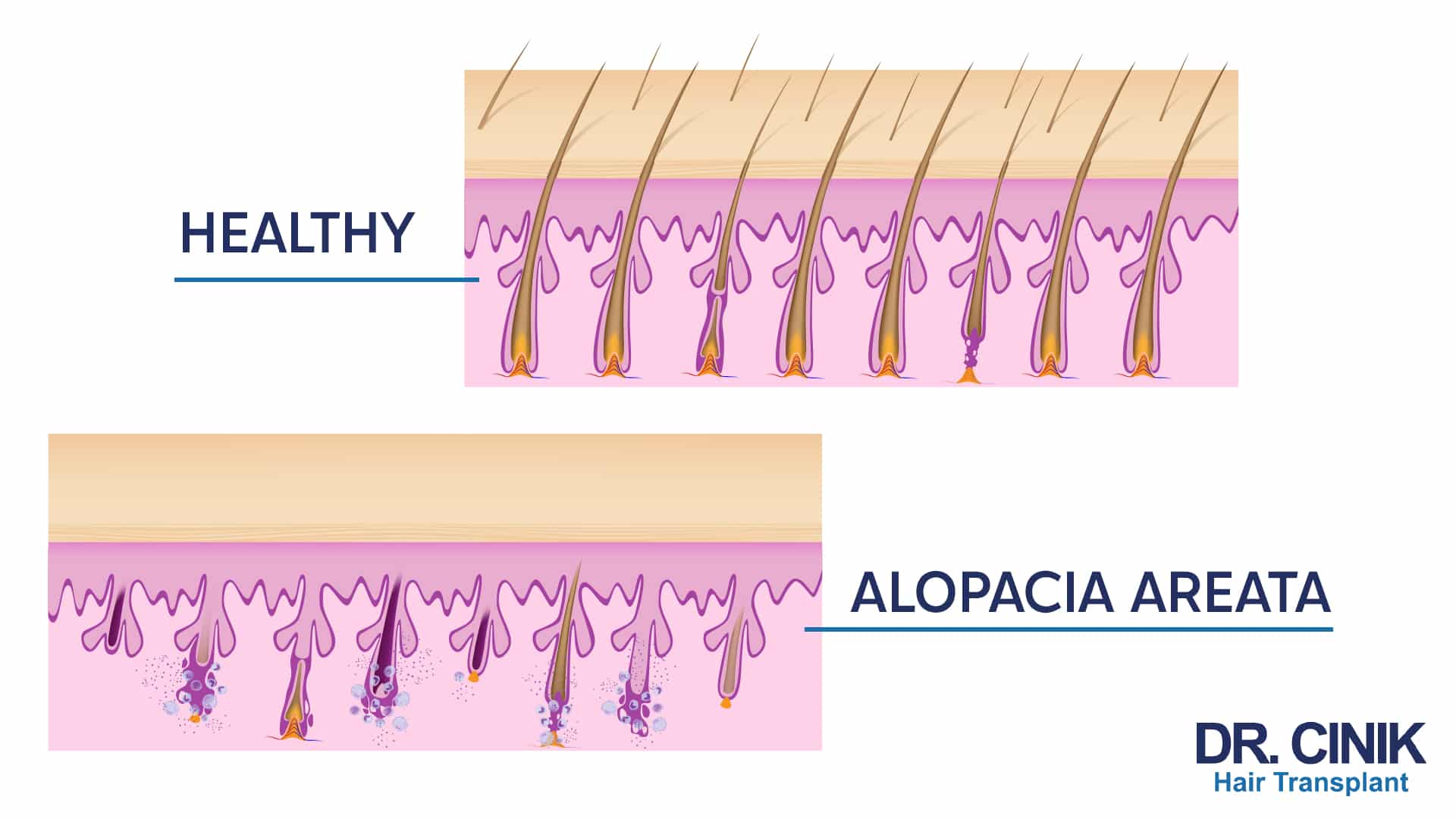Alopecia Areata: All about this autoimmune disease

Sommaire
Alopecia areata, characterised by patchy hair loss, was once deemed a psychosomatic disease but is now recognised as an autoimmune disorder. While it’s not life-threatening, it can profoundly affect an individual’s quality of life, often leading to substantial psychological distress. Gaining a clear understanding of its symptoms, causes, and potential treatments is essential for effectively managing this condition.

What is alopecia areata, also known as alopecia?
Alopecia areata is an autoimmune condition characterised by the loss of hair in localised, round patches. Although it can affect any hair-bearing body part, it most commonly impacts the scalp and beard area. This type of alopecia is referred to as “non-scarring,” implying that the hair follicles’ roots are not permanently damaged, and thus, hair regrowth is possible.
Diagnosing the disease: the main symptoms of alopecia areata in people with the disease
To diagnose alopecia areata, dermatologists or physicians typically perform a clinical examination and ask relevant questions to eliminate the possibility of other disorders, such as trichotillomania, pityriasis, or scarring alopecia. The disease can often be identified by the distinctive presentation of round, hairless patches. Sometimes, a scalp biopsy may be undertaken to confirm the diagnosis.

Hair loss in alopecia areata tends to progress gradually and can extend over larger or smaller areas and across different body parts. Some patients may feel slightly tingling or burning as the hair falls out. Changes in nail texture, such as the appearance of visible ridges across their surface, may also be observed.
Who is affected?
Alopecia areata occurs at any age, even in young children. It affects both men and women. Its lifetime prevalence is about 2%.
There is a genetic predisposition to this autoimmune disease. For example, there is a greater risk of developing patchy alopecia if one of the parents has suffered from it in their lifetime.
What are the leading causes of alopecia areata?
For a long time, alopecia areata was mistakenly considered a psychosomatic disorder. However, we now understand that this is incorrect. This condition is rooted in an autoimmune response, a fact that is now well-established. Let’s delve into its primary causes.

Autoimmune and inflammatory diseases
The primary cause of alopecia areata is an immune system malfunction. Similar to other autoimmune conditions, the body’s immune system mistakenly attacks its own cells. Specifically for alopecia areata, lymphocytes, a type of immune cell, target and damage the hair follicles, leading to hair loss.
It’s common for individuals with alopecia areata to have a personal history of other autoimmune disorders, such as thyroiditis, vitiligo, type 1 diabetes, or lupus.

Genetic and environmental factors
Genetic predisposition also plays a role in the onset of this condition. If a parent has experienced an episode of patchy hair loss during their lifetime, their children are at a higher risk of developing alopecia areata. Additionally, environmental triggers like intense stress can precipitate an episode of this disease.
The different types of alopecia aerata (alopecia)
Alopecia areata takes different forms depending on its extent and location on the body.

Patchy alopecia
Patchy alopecia is the most common form of the disease. The hair loss is localised in small round or oval areas, forming bare patches on the scalp or body.

Alopecia totalis
Alopecia totalis is a complete baldness of the head. This can follow a patchy alopecia that has spread.

Alopecia universalis
Alopecia universalis causes the loss of all hair and body hair. It is the most severe form of the disease, with a significant psychological impact.
What are the different treatment options?
Drug treatments
To counteract the detrimental impact of lymphocytes on hair follicles, corticosteroids are often prescribed as an initial treatment. If the alopecia patches are recent and not overly widespread, patients may apply cortisone in the form of cream, gel, lotion, or through local injections. For more severe cases, corticosteroids can be administered orally or via intravenous injections. Additionally, immunosuppressive drugs might also be prescribed in certain cases.

Alternative therapies
If alopecia areata is left untreated, spontaneous hair regrowth can sometimes occur within six months. During this period, patients might opt for hairpieces or camouflage techniques to mask the hair loss. Moreover, engaging in therapy can be beneficial to mitigate potential psychological distress and manage stress, thereby promoting overall well-being.

Why is hair transplantation never indicated in the treatment of alopecia?
Hair transplants are not recommended as this is an autoimmune disease. The immune system could attack the transplanted hair follicles. Other patches of hair loss could appear in other parts of the scalp, which would cancel out the effects of the transplant.
Advice and prevention for people with alopecia areata

Foods and nutrients beneficial to hair health
A balanced diet rich in essential nutrients contributes to healthy hair. Protein, omega-3 fatty acids, vitamin B and zinc are beneficial to the growth and strength of hair follicles. To achieve this, it is essential to eat fatty fish, lean meat, eggs, nuts, green vegetables and legumes. It is important to avoid foods that promote inflammation, such as coffee, alcohol, dairy products and sugar.

Habits to adopt to avoid recurrence
To avoid recurrences, it is recommended to adopt certain habits:
- Avoiding stress;
- Getting quality sleep;
- Engage in regular physical activity;
- Avoid aggressive hair products;
- Consult a dermatologist regularly.
 en
en



